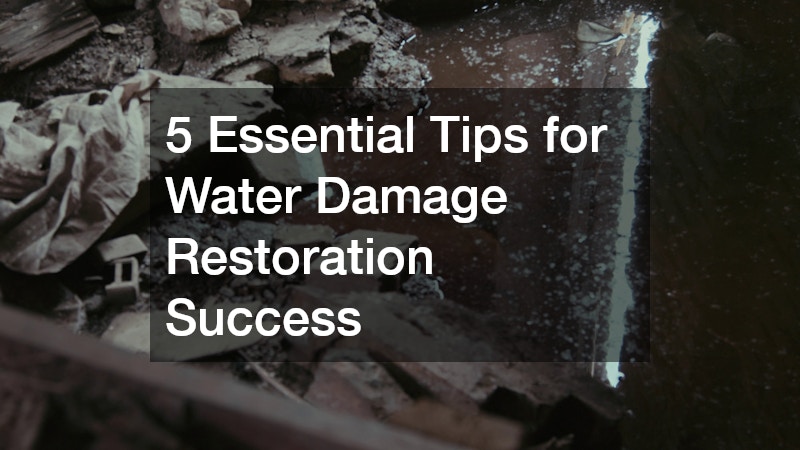Water damage can strike without warning, turning a peaceful home or business into a chaotic and potentially hazardous environment. Whether caused by flooding, burst pipes, or roof leaks, swift and efficient water damage restoration is critical to minimise long-term consequences. This process involves more than simply drying out wet carpets or furniture.
It requires a methodical approach grounded in safety, structural integrity and preventative thinking.
Without proper handling, water damage can compromise building materials, promote mould growth and even affect air quality. These risks make it vital to respond with a clear, informed plan. Understanding the essential steps to restoration can make all the difference in achieving successful outcomes.
Act Immediately to Prevent Secondary Damage
Timing is critical when dealing with water damage. The longer water sits in a structure, the more it seeps into walls, floors and furnishings. This delay can promote mould growth, weaken structural elements and increase the overall restoration costs. Immediate action ensures that moisture is contained and that additional damage is avoided. The first step in any restoration job should be to identify the source of the water and shut it off, followed by contacting a professional water damage restoration service. These professionals use specialised equipment such as moisture detectors and industrial dryers to expedite drying and assess unseen damage. Quick action is essential not only for the sake of the structure but also for the health of its occupants, as stagnant water can harbour harmful bacteria and airborne contaminants.
Ensure a Comprehensive Assessment of the Damage
Effective restoration cannot begin without a detailed inspection of the affected areas. This includes identifying the type of water involved—clean, grey, or black—as each requires different safety protocols. A clean water leak from a broken pipe is far less hazardous than contaminated water from sewage backups or natural flooding. Professionals will document every area touched by water, from flooring and walls to insulation and ceilings. This documentation is also crucial for insurance purposes. A clear understanding of the extent of the damage ensures nothing is overlooked during the restoration process. It also allows for an accurate estimate of time and cost, which helps manage expectations and timelines.
Use the Right Equipment & Techniques
Water damage restoration involves advanced tools and techniques that go beyond what household fans and dehumidifiers can offer. Industrial-grade air movers, desiccant dehumidifiers and moisture meters are essential in restoring properties to a safe and dry condition. The use of thermal imaging technology can identify hidden moisture behind walls and under floors, reducing the risk of undetected damage that could lead to future structural problems or mould infestations. Proper technique also means following a sequence: extraction of standing water, drying and dehumidifying, sanitising affected areas and finally, repairing or replacing damaged materials. Each phase must be executed with precision to ensure full recovery and a safe environment.
Prevent Mould Growth with Proactive Measures
Mould can begin to grow within 24 to 48 hours after water damage occurs, making it one of the most urgent concerns during restoration. It can not only damage the structure further but also pose significant health risks, especially for individuals with respiratory issues. Preventing mould begins with thoroughly drying all affected areas and removing items that cannot be salvaged, such as saturated drywall or insulation. Disinfectants and antimicrobial treatments are used to clean surfaces and prevent spores from taking hold. Ventilation is also critical and in some cases, air scrubbers may be used to filter out contaminants. Staying vigilant for signs of mould even after restoration is complete is crucial to long-term health and safety.
Work with Trusted Professionals & Maintain Clear Communication
The success of any water damage restoration effort hinges on the quality of the professionals involved. Reputable contractors bring not only the right tools and expertise but also the experience to handle unexpected complications. They understand local building codes, can liaise with insurance providers and are equipped to make critical decisions in high-pressure situations. Clear communication is vital throughout the process. Property owners should receive regular updates and be involved in any decisions affecting repair or replacement. Transparency around timelines, costs and risks ensures trust and satisfaction with the final outcome. Choosing a licensed and insured company provides peace of mind and ensures compliance with Australian safety standards.
Restoring with Confidence: Achieving Long-Term Success After Water Damage
Water damage restoration is a complex task that requires immediate attention, technical expertise and ongoing communication. Success is achieved not just by drying out an area, but by restoring it in a way that ensures long-term safety and usability. Acting fast, conducting a detailed damage assessment, using specialised equipment, taking steps to prevent mould and working with trusted professionals are all key components of an effective strategy. By understanding and applying these essential tips, property owners can recover from water damage more efficiently and avoid the pitfalls of incomplete or substandard restoration. With the right approach, even the most severe water intrusion can be managed with confidence and clarity.


